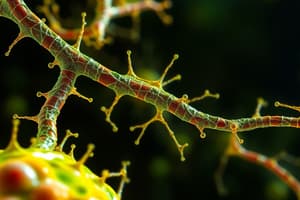Podcast
Questions and Answers
The functions of the extracellular matrix include:
The functions of the extracellular matrix include:
- supporting differentiation. (correct)
- inducing morphogenesis. (correct)
- binding growth hormones. (correct)
- all of the above
The major families of cell surface adhesion molecules include:
The major families of cell surface adhesion molecules include:
- cadherins and selectins. (correct)
- integrins. (correct)
- the Ig-superfamily. (correct)
- all of the above
Cadherin cellular adhesion molecules promote:
Cadherin cellular adhesion molecules promote:
- collagen binding.
- multiadhesive matrix protein binding.
- cell-specific homophilic interactions. (correct)
- all of the above
Desmosomes:
Desmosomes:
Which of the following statements best describes the difference between low-affinity integrins and high-affinity integrins?
Which of the following statements best describes the difference between low-affinity integrins and high-affinity integrins?
Vertebrate gap junctions are composed of:
Vertebrate gap junctions are composed of:
A tight junction is made up of which of the following proteins?
A tight junction is made up of which of the following proteins?
Cellular responses to adhesion receptor signaling do NOT include:
Cellular responses to adhesion receptor signaling do NOT include:
Which of the following is the term used to describe a thin, sheet-like meshwork of extracellular matrix components that can be found in epithelial cells?
Which of the following is the term used to describe a thin, sheet-like meshwork of extracellular matrix components that can be found in epithelial cells?
Basal lamina include all of the following, except:
Basal lamina include all of the following, except:
Which one of the following is NOT a property of perlecan?
Which one of the following is NOT a property of perlecan?
The collagen triple-helix domain is NOT:
The collagen triple-helix domain is NOT:
Proteoglycans are:
Proteoglycans are:
Syndecans are cell-surface proteoglycans that:
Syndecans are cell-surface proteoglycans that:
Biological roles of proteoglycans and hyaluronan include all of the following, except:
Biological roles of proteoglycans and hyaluronan include all of the following, except:
Which extracellular matrix component is expressed in a cell-specific manner and binds to the tripeptide sequence Arg-Gly-Asp?
Which extracellular matrix component is expressed in a cell-specific manner and binds to the tripeptide sequence Arg-Gly-Asp?
Polymerization of collagen into large collagen fibers occurs:
Polymerization of collagen into large collagen fibers occurs:
Hydroxyproline is important in the formation of staple collagen polymers within cells. The formation of hydroxyproline requires:
Hydroxyproline is important in the formation of staple collagen polymers within cells. The formation of hydroxyproline requires:
Which of the following is NOT true regarding matrix metalloproteases?
Which of the following is NOT true regarding matrix metalloproteases?
Heparan sulfate, an example of a(n) ______ , aids in the activation of ______ .
Heparan sulfate, an example of a(n) ______ , aids in the activation of ______ .
NCAMs, a group of cell-adhesion proteins belonging to the Ig superfamily:
NCAMs, a group of cell-adhesion proteins belonging to the Ig superfamily:
Dystroglycan is a large glycoprotein that binds to dystrophin in muscle cells. It is also present in other cells and can also bind to:
Dystroglycan is a large glycoprotein that binds to dystrophin in muscle cells. It is also present in other cells and can also bind to:
Which of the following best describes the structure of integrins?
Which of the following best describes the structure of integrins?
What signal is released by endothelial cells to recruit circulating leukocytes?
What signal is released by endothelial cells to recruit circulating leukocytes?
People with a defect in the synthesis of the integrin β2 subunit exhibit reduced:
People with a defect in the synthesis of the integrin β2 subunit exhibit reduced:
What effect might an injection of RGD peptide have on tumor cells moving through the blood/lymph system?
What effect might an injection of RGD peptide have on tumor cells moving through the blood/lymph system?
As fibroblasts form a three-dimensional structure in contact with the ECM, the cells bound to ECM:
As fibroblasts form a three-dimensional structure in contact with the ECM, the cells bound to ECM:
Pectins and hyaluronic acid are both:
Pectins and hyaluronic acid are both:
Which of these is NOT a component of plant cell walls?
Which of these is NOT a component of plant cell walls?
Flashcards
Extracellular Matrix Functions
Extracellular Matrix Functions
ECM supports cell differentiation, induces structural development, and binds growth factors.
Cell Adhesion Molecules Families
Cell Adhesion Molecules Families
Cadherins, integrins, and the immunoglobin superfamily are key cell adhesion families.
Sponge Cell Aggregation
Sponge Cell Aggregation
Sponge cells aggregate based on species-specific calcium-dependent interactions of ECM proteins and cell surface receptors.
Cadherin Function
Cadherin Function
Signup and view all the flashcards
Desmosome Composition
Desmosome Composition
Signup and view all the flashcards
Integrin Affinity Types
Integrin Affinity Types
Signup and view all the flashcards
Gap Junction Proteins
Gap Junction Proteins
Signup and view all the flashcards
Tight Junction Proteins
Tight Junction Proteins
Signup and view all the flashcards
EDTA's Effect on Cells
EDTA's Effect on Cells
Signup and view all the flashcards
Gap Junction Function
Gap Junction Function
Signup and view all the flashcards
Hemidesmosome cytoskeleton
Hemidesmosome cytoskeleton
Signup and view all the flashcards
Polarized Epithelial Cell
Polarized Epithelial Cell
Signup and view all the flashcards
Basal Lamina Composition
Basal Lamina Composition
Signup and view all the flashcards
Proteoglycan Function
Proteoglycan Function
Signup and view all the flashcards
Collagen Triple Helix
Collagen Triple Helix
Signup and view all the flashcards
Matrix Metalloproteases (MMPs)
Matrix Metalloproteases (MMPs)
Signup and view all the flashcards
Fibronectin Forms
Fibronectin Forms
Signup and view all the flashcards
Collagen Amino Acid Types
Collagen Amino Acid Types
Signup and view all the flashcards
Syndecan Function
Syndecan Function
Signup and view all the flashcards
Plant Cell Wall Components
Plant Cell Wall Components
Signup and view all the flashcards
Plasmodesmata Function
Plasmodesmata Function
Signup and view all the flashcards
Study Notes
Extracellular Matrix Functions
- Supports cell differentiation
- Induces morphogenesis
- Binds growth hormones
Cell Surface Adhesion Molecules
- Major families include cadherins, selectins, integrins, and the immunoglobulin superfamily
Sponge Cell Aggregation
- Cells from the same species aggregate
- Cells from different species do not adhere
- Calcium-dependent interactions
- Homotypic proteoglycan aggregation factors
- Bind to surface receptors within the extracellular matrix
Cadherin Function
- Cell-specific homophilic interactions
Desmosomes Structure
- Associated with actin filaments on the cytoplasmic side
- Contains desmoglein and desmocollin transmembrane proteins
Integrins: Low vs High Affinity
- Integrins exist in low-affinity (bent) and high-affinity (straight) conformations
- Integrin dissociation can shift from low to high-affinity state
Studying That Suits You
Use AI to generate personalized quizzes and flashcards to suit your learning preferences.
Description
Explore the intricate functions of the extracellular matrix and cell surface adhesion molecules in this detailed quiz. Delve into topics like cadherins, desmosomes, and integrins, and their roles in cell differentiation and aggregation. Perfect for students of cell biology looking to strengthen their understanding.


